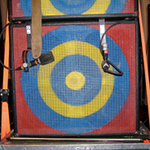Ellen K. Levy: CAA Book Author Interview
This is the first in a series of short interviews with the authors of The Eye, the Hand, the Mind: 100 Years of the College Art Association, a book edited by Susan Ball and published in conjunction with CAA’s Centennial.
Ellen K. Levy
An artist based in New York, Ellen K. Levy is completing a PhD for artists involved with science and technology at the Zurich Node of the Planetary Collegium (Z-Node), in collaboration with the University of Plymouth in Plymouth, England. She has taught at Brooklyn College, the School of Visual Arts, and Cooper Union and showed her work at Michael Steinberg Fine Art in New York until its closing in 2009. Ellen Levy: Norms of Behavior is on view April 7–May 1, 2011, at the UCLA Art | Sci Gallery in Los Angeles, and at the Museum of Modern Art in Kiev, Ukraine.
Levy’s chapter, “Art in an Academic Setting: Contemporary CAA Exhibitions,” focuses on the organization’s role in supporting artists and exhibitions in recent decades. She explores the annual Regional MFA Exhibitions, which began in 1989 in San Francisco, and researched the shows that coincided with the Annual Conference, including Techno-Seduction, held in New York in 1997, and New Space, New Audience, CAA’s first and only online exhibition from 2001.
What was the most surprising thing that you learned about CAA during your research and writing?
In looking through records about past exhibitions, I was surprised to learn the extent of CAA’s traveling exhibition program, especially between 1929 and 1935. For example, CAA organized and circulated exhibitions at such major museums as the Brooklyn Museum and the Detroit Institute of Arts. Other times artwork was shown at smaller museums, often at universities such as Brown and Howard, and at commercial galleries, including Silberman and Wildenstein.
How has your work on the book changed your perception of the organization?
My work confirmed my belief that CAA needs more input from artists. It also underscored the importance of having an organization that is critically involved with standards and guidelines on a multitude of topics.
Before joining the book project, you worked closely with CAA in various capacities. What were your roles? How important has CAA been to the direction your career has taken?
Several projects that I did were highly important to my development as an artist and educator and have informed my present work in art and neuroscience. Working with Berta Sichel, I guest edited a special issue of Art Journal, called “Contemporary Art and the Genetic Code,” in 1996. This was the first in-depth academic publication about this subject; contributors included Stephen J. Gould, Roald Hoffmann, Joe Davis, Dorothy Nelkin, and David Kremers.
In addition, I was chair of the Studio Art Thematic Sessions for the 2000 conference in New York. My theme, “Modeling Nature,” developed in conjunction with the art-history cochairs Betsy Rosasco and Sarah Blake McHam, explored interrelationships among art, science, and technology. Conference themes have not been continued since then, but the experience was exhilarating, in part because we included participants from outside the art field.
From 2004 to 2006 I served as president of CAA, which was a remarkable time and experience. Within months after I became president, the artist Steve Kurtz had been accused of bioterrorism, and CAA issued a statement of support for him. During this two-year period, the organization became involved in other key issues ranging from stolen antiquities to intellectual property.
What were the watershed moments in the areas that you investigated? What do you want readers to take away from your chapter?
Realizing how difficult this time is economically, I nevertheless hope that CAA members recognize that exhibitions are essential to our mission. It is especially important that CAA offer alternatives to the commercial art world.
How should CAA move forward into the next one hundred years? What has the organization addressed well, and what unexplored territories or constituencies should it begin to explore?
Artists involved with nanoart and bioart have been addressing the ethical implications of displaying living matter, maintaining semiliving forms, and exploring neurogenetic enhancements. Other artists have introduced new approaches to physical and cognitive deficiencies such as autism by considering the eye’s gaze; they’ve also provided relief to chronic pain though biofeedback and virtual-reality techniques. Art education would do well to analyze the activities of these artists and others whose work deals with, for example, global warming and the environment. Since their results rarely manifest in forms recognized by the art market, CAA should support such work with an exhibition program. Relatedly, it’s excellent that a CAA task force is examining the use of animals in art along with issues raised by human performance.
Collaboration is also crucial. As an umbrella arts organization, CAA should follow the lead taken by the Humanities, Arts, Science, and Technology Advanced Collaboratory (HASTAC) to foster partnerships among diverse academic disciplines—especially with the social sciences and supercomputing interests—to advance research and teaching and improve public outreach.
Originally published on the CAA website on April 13, 2011.
